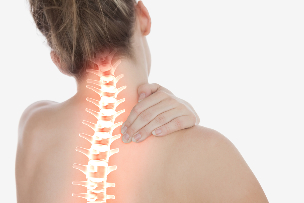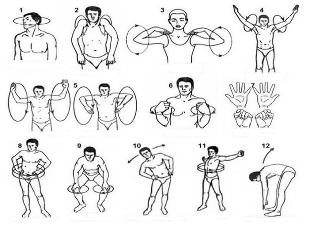It Is now rarely encountered manifestations of the wide spread of this disease: according to statistics, about 60% of the population in developed countries, in varying degrees, suffer from manifestations of osteochondrosis. The main reason for this is the distribution, sedentary jobs, lack of and movement of the modern man.

Osteochondrosis of the cervical spine (Osteohondroz) is a degenerative-dystrophic lesions of the intervertebral discs, which is the damaged disc, the vertebrae and joints of the cervical, lower the height of the intervertebral discs. If untreated, the Disease progresses and can cause headaches, circulatory problems and even hernia. Like osteoporosis, the disease paid because of disorders of mineral metabolism, causing the bones of the joints become and the less strong.
Osteochondrosis can cause instability of the cervical spine (the symptoms treatment and are similar to the chondrosis, but has a number of features), which is often associated with displacement of the vertebrae. This in turn accelerates the development of degenerative disc disease, destroying the backbone of the Department.
Osteochondrosis of the cervical spine: symptoms
The initial stage of the disease is almost manifest painful symptoms of fb: you may feel pain in the neck, or after physical big burden for long-term sitting in a tense position after or sudden movement of the tilt head.
The main symptoms – headache, dizziness, impaired coordination, and, light crunch, when moving the head, weakness; less frequently observed weakness in the hands, numbness, slurring speech and language, problems with breathing, vision, hearing, sweating, abnormally high blood pressure. The most important areas – head, neck, collar area. In most cases, at the same time, there are a few unnecessary listed symptoms.
Usually osteoarthritis symptoms are not obvious use of masks the use of painkillers. This is one of its dangers: most of the symptoms it is possible other diseases, complicating the diagnosis of cervical degenerative disc disease.
Dizziness with cervical osteochondrosis
This condition is not always clearly demonstrated degenerative disc disease of the cervical spine.
Dizziness can be caused by:
- inflammation near or in the inner ear;
- spasms of cerebral vessels;
- violations transmission of nerve impulses;
- problems with the vestibular apparatus;
- diseases of the cardiovascular system.
There are no clear criteria, dizziness osteochondrosis. However, systemic still there and non-systemic dizziness, they have clear differences.
Know It is recommended systemic differences and non-systemic dizziness, this will help determine the causes of unusual States:
- system vertigo is a sense of circular motion of the surrounding objects or the body, which is the result of disruption of the vestibular apparatus, visual and analyzer are receptors in joints, muscles, and skin (lower back pain of various etiologies);
- non-systemic dizziness is a feeling, fainting, feeling shocked, uncertain state in an upright position. When the not-for-bulking-systemic dizziness circular rotation is missing, and this is the main difference compared to brands.
People who feel dizzy to one particular type should be checked by an experienced doctor, primarily a neurologist or (if there is a suspicion of disease of the ear field, and throat) an otolaryngologist.
The reason for hospitalization, the emergency is not related to degenerative disc disease of the cervical spine, have the patient identifying information (except the dizziness) of such mark by:
- facial paralysis and a comfortable shoulder strap;
- severe headache on the background of deterioration of health;
- violation of coordination of movements;
- loss or consciousness loss.
Headache in cervical osteochondrosis
This is one of the most common non-specific signs of many diseases. Headaches are especially common women. It is difficult to determine the cause of headaches, and combine it in addition to the damage to the spine. There are 14 different reasons for headache in humans.
The most common causes of headaches described in the pathology:
- spasms of cerebral vessels;
- pinched nerve roots;
- a reflex increase in intracranial pressure.
Headache in cervical osteochondrosis can remember the feeling, when hypertension, angina pectoris, or stroke. In particular, middle-and older age, usually the risks of developing strokes or heart attacks.
Feel that can be a pain paroxysmal, persistent, pulsating, and boring.
When heart disease, patients complain of discomfort in the chest, accompanied by a rhythm disturbance of the heart. To identify the cause of unnecessary qualified doctor. If the headache combined with nausea, dizziness and chest pain, make sure of the ECG.
Pain in osteochondrosis of the cervical
Not always the pain is localized in the head and neck. Known cases different localization of pain.
Neck pain can radiate to the shoulder area and across the hands. Feature of such sensations is the sudden bouts after sleep, sudden movements, invisible to the human stress, for example, when you laugh or sneeze. Pain associated with degenerative disc disease, process if not taken on a chronic nature, usually disappear in a short time, and along with the crunch of the cervical vertebrae.
Spot before the query should eliminate the pain by using manual therapy (massage). In some cases, inept handling can worsen the pathology, disrupt innervation or cause injury to the patient.
The intensity of the pain can be mild to sharp. Time – as well as the ny a short long.
See is that cervical osteochondrosis most often associated with injury and the sixth to the seventh cervical vertebra.
There are tests to determine the localization of the pain impulse. Loss of the area of the sixth vertebrae is supplemented with pain in the thumb, a loss in the region of seven vertebrae, it is accompanied by pain in the middle finger.
Blood pressure, cervical osteochondrosis
The ratio of cervical degenerative disease, irregular blood pressure plate has long been established. The cervical vertebrae are important of nerve endings and blood vessels.
Characteristic pressure changes during the day. Hypertension for a long time not typical for this disease. Reflex irritation of the nerve endings and the short-term spasms of the blood vessels, causing a sudden the clock the dynamics of hypertension.
Features elevated cervical osteochondrosis is a combination of the following symptoms:
- headache;
- pain and limbs in the chest;
- to reduce the sensitivity of the neck area;
- the occurrence of pressure peak after stress, muscle tension, prolonged stay in an uncomfortable position and other similar situations.
Spikes HELL and health are the rapid deterioration of the foundation seek immediate medical help.
In the development phase of osteochondrosis
The development of cervical degenerative disc disease, I decided to share 4 steps. But this is rather a conditional distribution, because most of the symptoms of the disease may occur in other diseases.
In the first stage (pre-clinical)
Early stages of mild and symptoms are often attributed to stress or other diseases. It feels like a bad, stiff neck, pain sharp movements or tilts. At this stage it is possible to get rid of nascent degenerative disc disease using therapeutic exercise or more to move in vain, to adjust the power.
The second stage
Confirmed Pain and become permanent during or steep timonen studying in london slopes are already strong. Severe headaches, the patient began to get tired, become distracted, sometimes numb areas of the face.
The third step
Disc herniation often causes dizziness, weakness in hands, pain experienced in the neck and the hands, always feel shoulders.
The fourth step
Eventually, the intervertebral discs are destroyed, they are replaced by connective tissue. Zaselyalsya nerves, which leads to difficulty in movement, severe pain, increased dizziness, noise in the ears is.
Causes and risk factors
Oddly enough, the possibility of developing osteoarthritis in humans is, as one of its evolutionary advantages of erect posture: vertebrae press against each other, and with age the connective tissue breaks down. As a result, the parents, it is almost inevitable process. But there are many factors that contribute to earlier and more intensive development of osteochondrosis:
- In the first place – and it is sedentary sedentary lifestyle, often observed in modern life (office workers, drivers and other sedentary profession, TV, long hours at the computer), lack of exercise
- Hard, unnatural position in the process: a person often for example, a computer leaning forward, adopting a tense pose
- On the contrary, the reason – too high, unusual for this person to load, but it's in danger – even for trained athletes, e.g. weightlifters;
- Whatever the reason, which violates the natural posture of man: uncomfortable shoes, especially high heels, poor posture when sleeping, flat feet, arthritis, scoliosis;
- Overweight, often due to malnutrition
- Frequent stress, severe stress, constant fatigue
- Local hypothermia
How is dangerous the cervical osteochondrosis
At the nape there are many vital blood vessels, arteries, capillaries, and therefore can be a possible violation of the unpleasant consequences, such as hypoxia, hypertension, vascular dystonia.

Cervical degenerative disc disease affects the spine in the segments of operation of the control and the shoulder to the elbow joints, thyroid, and other hands bodies. Osteochondrosis, if it is not treated, the likelihood of pinched nerves, compressed blood vessels, which will inevitably affect the work of other bodies.
How to treat cervical osteochondrosis
Real, stable success of cervical degenerative disc treatment can be achieved by the disease only an integrated approach, which includes medications, neck massage, therapeutic exercises, occupational therapy. Very advanced cases may require surgical intervention.
We recommend that you do not resort to self-treatment, primarily due to the fact that the symptoms of lower back pain can mean a completely different disease: in addition, that no more than your choice of medication in treatment, he can still cause damage.
The withdrawal of acute pain
Osteochondrosis, especially in the later stages, is associated with severe pain, so the first task of the doctor is to ease man suffering. He will prescribe painkillers, anti-inflammatory drugs, vitamins, chondroprotectors to restore cartilage tissue, drugs, improves blood circulation and reduces spasm of muscles.
Therapeutic exercises with cervical osteochondrosis
The easiest and available, including house method – occupational therapy. Although it is also quite effective, because it will strengthen and neck muscles to restore blood flow to damaged areas, to compensate for the lack of movement in everyday life. Occupational therapy can be supplemented with swimming i, Aqua-gym.
Occupational therapy is easily affordable and shape of cervical degenerative disc disease and, at the same time, quite effective. Care to teach at home can be done. Osteochondrosis of the intensity of training is not critical, in vain the frequency. First, the physical training is designed to strengthen the neck muscles, which form the lack of functionality of the spine to help and support the weakened vertebrae.

Strengthen the muscles of the neck is recommended daily activities. They can be quite simple, consisting of rotations and head tilts in different directions, and the more complex, including using the neck muscles of the arms. He can perform both at work and at home. For example, if your Work is sedentary, it is useful to do these exercises for an hour after sitting at a desk or monitor.
Occupational therapy
Correct and consistent use of occupational therapy techniques improve blood flow to the damaged areas, to reduce inflammation and pain, slowing ossification.
Osteochondrosis of the cervical used for electrophoresis, magneto therapy, laser therapy, shock wave therapy, medical baths and showers, mud therapy and other methods.
Neck massage with osteochondrosis of the cervical spine
Osteochondrosis massage can be very effective: it improves blood circulation, reduces spasms by reducing muscle tone, alleviate pain symptoms and improve the General condition of the patient.
But massage therapy and manual must comply with extreme caution, because of the ny influence inept rude to patients areas of the body can do unnecessary damage.
Surgical treatment
In very advanced cases excluded is not, although surgery: narrowing of the spine disc herniation spinal discs, spondylolisthesis at.
The decision about the need for and method of surgical intervention is taken by the surgeon, he determined, preparatory activities, the duration and the postoperative rehabilitation.






















